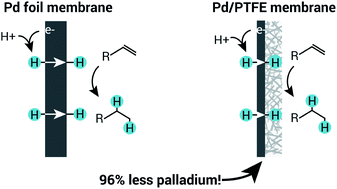Supported palladium membrane reactor architecture for electrocatalytic hydrogenation†
Abstract
Electrolytic palladium membrane reactors offer a means to perform hydrogenation chemistry utilizing electrolytically produced hydrogen derived from water instead of hydrogen gas. While previous embodiments of these reactors employed thick (≥25 μm) palladium foil membranes, we report here that the amount of palladium can be reduced by depositing a thin (1–2 μm) layer of palladium onto a porous polytetrafluoroethylene (PTFE) support. The supported palladium membrane can be designed to ensure the fast diffusion of reagent and hydrogen to the palladium layer. The hydrogenation of 1-hexyne, for example, shows that the supported Pd/PTFE membrane can achieve reaction rates (e.g., 0.71 mmol h−1) which are comparable to 0.92 mmol h−1 measured for palladium membranes with a high-surface area palladium electrocatalyst layer. The root cause of these comparable rates is that the high porosity of PTFE enables a 12-fold increase in electrocatalytic surface area compared to planar palladium foil membranes. These results provide a pathway for designing a cost-effective and potentially scalable electrolytic palladium membrane reactor.



 Please wait while we load your content...
Please wait while we load your content...